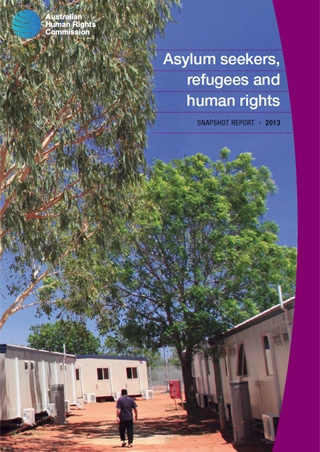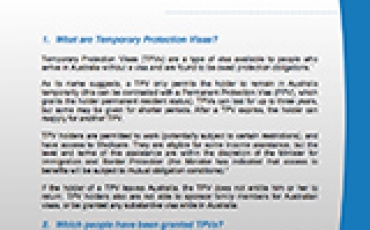Asylum seekers, refugees and human rights - Snapshot Report

Executive Summary
The purpose of this report is to provide an overview – or ‘snapshot’ – of the key human rights issues that arise from Australia’s approach to asylum seekers and refugees who arrive by boat.
The report focuses on mandatory immigration detention and third country processing. It concludes with observations on some of the policy changes proposed by the newly elected Australian Government.
The report is not intended to address all the issues facing asylum seekers and refugees in Australia.
Asylum seeker and refugee policy remains one of the most contentious issues in contemporary Australia. In recent times we have seen a number of policy changes in this area. The speed at which they occur can make it challenging to stay on top of the facts. It is my hope that this report will provide parliamentarians, key commentators and the community with a clear understanding of the human rights issues that arise from the situation facing asylum seekers and refugees who arrive in Australia by boat.
This report reveals a significant gap between Australia’s human rights obligations under international law and the current treatment of asylum seekers and refugees.
Australia maintains one of the most restrictive immigration detention systems in the world. It is mandatory, not time limited, and people are not able to challenge the need for their detention in a court of law. The Commission has for many years called for an end to this system because it leads to breaches of human rights obligations under treaties to which Australia is a party.
While doing so, the Commission has also acknowledged that immigration detention may be legitimate for a strictly limited period of time. However, the need to detain a person should be assessed on a case-by-case basis taking into consideration their individual circumstances.
The United Nations Human Rights Committee’s most recent finding against Australia related to the indefinite detention of refugees with adverse security assessments. The Committee not only found that these refugees’ indefinite detention was arbitrary, it also found that it was ‘inflicting serious psychological harm upon them’, which amounted to cruel, inhuman or degrading treatment.
As at 5 September 2013, there were 6,579 people in closed immigration detention facilities in Australia, including 1,428 children. As at 6 August 2013 there were 52 refugees being held in indefinite detention as a result of receiving an adverse security assessment. The detrimental mental health impact of prolonged and indefinite detention is well-documented. In 2012–13 there were 846 reported incidents of self-harm across Australia’s immigration detention network.
While numbers in closed detention remain high, Australia has taken significant steps towards implementing a system of community placement on the mainland for asylum seekers and refugees. This has been achieved through the use of community detention and bridging visas, building on measures introduced by successive Australian governments. This is a welcome development, aspects of which align with the Commission’s recommendations and international human rights standards.
The Commission continues, however, to hold significant concerns that the denial of work rights to asylum seekers on bridging visas (reported on 2 September 2013 to be over 21,000) may force individuals and families into poverty and lead to breaches of multiple human rights.
Of particular concern is the introduction of an ‘enhanced screening process’ for all unauthorised maritime arrivals from Sri Lanka. The Commission considers that this process does not constitute a fair asylum procedure and risks excluding those with legitimate claims for protection.
In 2012 the Australian government reinstated third country processing. This was prompted by the rising number of asylum seekers undertaking dangerous sea journeys to seek protection in Australia and by the tragic loss of lives at sea. The Commission acknowledges that preventing further deaths at sea is a complex challenge with no simple solutions.
As at 5 September 2013 there were 1,254 asylum seekers detained on Nauru and Manus Island in Papua New Guinea.
In June 2013 the Parliamentary Joint Committee on Human Rights, having examined the laws and legislative instruments underpinning the regional processing regime, concluded that there was a significant risk that the regime was incompatible with a range of human rights. The Commission concurs with this assessment.
Australia has resettled around 800,000 refugees since World War II, building one of the world’s most successful multicultural societies. Today, Australia continues to have a generous resettlement programme and, along with the United States and Canada, has ranked consistently among the world’s top three resettlement countries.
While we have seen a significant increase in asylum seekers seeking protection in Australia in recent times, Australia’s share of asylum applications remains a very small fraction of the global total (about 2.2%). I urge the Australian Government to ensure that all asylum seekers and refugees are treated humanely regardless of their mode of arrival, and to continue to uphold our proud history of providing protection to some of the world’s most persecuted and vulnerable people.
Gillian Triggs
President


